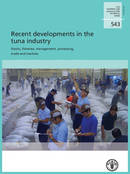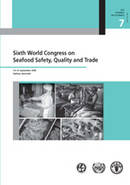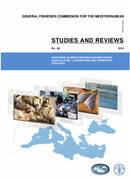出版物
he first half of the paper introduces the conditions under which the studies were made and the data sources. It first provides caveats and assumptions which are designed to prevent misunderstanding or misinterpretation when using the data. It then reviews the world tuna stock status based on the results of Regional Fisheries Management Organizations (RFMOs) scientific reviews. Even though the biomass of most of the world’s tuna stocks is generally above but close to the...
Fish and fish products are among the most traded food commodities: close to 40 percent by volume ends up in international markets. About half of those exports by value originate in developing countries.
Sixth World Congress on Seafood Safety, Quality and Trade. Sydney, Australia,14–16 September 2005. Edited byDavid JamesConsultantFAO Fisheries and Aquaculture DepartmentLahsen AbabouchChiefFish Utilization and Marketing ServiceFAO Fisheries and Aquaculture DepartmentandSally WashingtonConsultantFAO Fisheries and Aquaculture DepartmentFAO Fisheries Proceedings
Social and biophysical dimensions of ecosystems are inextricably related such that a change in one dimension is highly likely to generate a change in the other. Although change is a natural consequence of complex interactions, it must be monitored and even managed if the rate and direction of change threatens to undermine system resilience.
"An ecosystem approach to aquaculture (EAA) is a strategy for the integration of the activity within the wider ecosystem such that it promotes sustainable development, equity,...
The purpose of this report is to provide an overview of the marine aquaculture industry in the Mediterranean and its markets based on national country reports submitted by national marketing experts selected in the Mediterranean countries.
This document is an output of the project “Support to the GFCM Working Group on Marketing of Aquaculture Products: Development of a Strategy for Marketing and Promotion of Mediterranean Aquaculture (MedAquaMarket)”. The purpose of this report is to provide an...
The main purpose of these Technical Guidelines is to provide general advice in support of implementation of Articles 11.2 "Responsible international trade" and 11.3 "Laws and regulations relating to fish trade", of the Code of Conduct for Responsible Fisheries. These guidelines assist in the further dissemination, understanding and implementation of the Code of Conduct for Responsible Fisheries worldwide.
The guidelines are particularly important for two reasons: i) fish and fish products are among the most...






